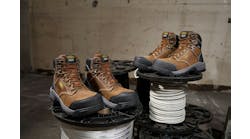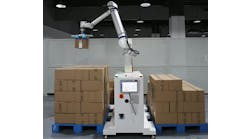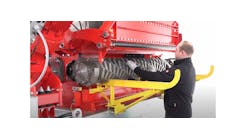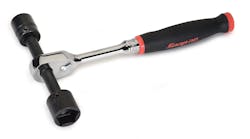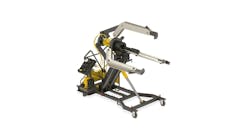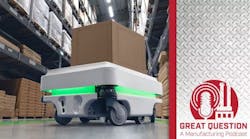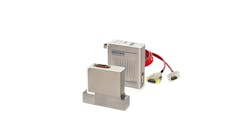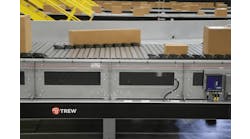Hatebur Metalforming Equipment Ltd. is known for its cold-forming production machines marketed under the Hatebur-Coldmatic trade name. Three models of these machines are used by forgers around the world — the AKP 3-5, AKP 4-5 and AKP 5-5 models.
In April 2004, at the Wire 2004 trade show in Dsseldorf, Germany, Hatebur introduced the concept of a larger Coldmatic machine, with more forging power and six forging stages. In April 2005, Hatebur unveiled for customers the first working Coldmatic AKP 4-6 S, at its plant in Reinach, Switzerland.
For six days, more than 200 visitors viewed the new machine in operation producing a double-sided pinion. Then, the new machine was shipped to a customer to be put into production. It’s key features include:
- Compatibility with Hatebur-Coldmatic AKP 4-5 machines
- Linear in-feed system
- High-speed shearing system
- Separation of perfect parts and scrap
- Variblock quick-change system
Increased forming load, and - Six forming stations for producing complex part geometries.
As noted, the Hatebur-Coldmatic AKP 4-6 S supplements the series’ three previous models. Its six forming stations make it capable of producing components with more complex part geometries.
To provide the higher forming loads required, both the total forming load capacity and the forming capacity per station were increased.
The seventh gripper of the transfer unit ensures that the good parts — and only these — are gently directed onto the transfer conveyor. In turn, this ensures these parts are free of impact marks. Should any parts not be out of shape, the seventh gripper of the transfer unit opens via an electro-hydraulic system and the part falls into a waste discharge chute. The part is directed out of the machine on a waste conveyor.
The first gripper of the transfer unit works similarly. For example, if stainless steel material is being used, induction heating might be necessary before forming takes place. The temperature of the incoming material is checked and until the proper temperature is reached, the first gripper remains open so that the parts are transported out of the machine via the waste discharge chute. Only after the required temperature is reached is the gripper electro-hydraulically activated to carry the blank to the first station.
To separate good parts from waste, there is a new arrangement of the discharging conveyors. The parts conveyor is above, and the waste conveyor below, providing for easy maintenance positioning.
The conveyors move through oil-tight enclosures. The slanted orientation of the conveyors causes dripping oil to be collected and removed at their lower ends.
Noise abatement measures on the conveyors and the connected part containers improve working conditions for the operator.
Production flexibility, a notable characteristic of the other Hatebur-Coldmatic machines, is incorporated in the new machine, too. For example, forming is possible on the die-side as well as on the punch-side.
Scaling up of the new machine’s parameters was done so that various key components are the same as in the AKP 4-5. For example, forming tools and transfer grippers of the AKP 4-5 can be used on the new AKP 4-6 S. This is an important advantage for operators who want to add the new machine to an operation with AKP 4-5. The compatibility of these machine components with those already available on other machines lowers the overall costs of equipment and spare parts procurement.
The most important objective of the new machine is the manufacture of cold-formed parts with high precision. The precision level is determined in part by the in-feed, cut-off, and transfer mechanisms.
The linear in-feed system ensures that material in-feed is very precise and that damage to the wire surface with roll-in feeds is avoided. The linear in-feed requires no wire stop, which eliminates the occurrence of contact marks.
The in-feed length is measured by a process calculator that receives its signals from an incremental transmitter. The actual value of the cut-off must lie within two tolerance limits. On one hand, the total tolerance must move within a prescribed bandwidth. The deviation from cut-off to cut-off, on the other hand, is measured and compared with the given tolerance limits.
The high-speed shearing system produces quality blanks, characterized by rectangularity, freedom from flash, and volume consistency, which directly influence the forming result. A pre-accelerated hammer transmits an impulse to the closed shear blade. The resulting shock wave, speeding ahead of the mechanical movement, separates the cut-off from the wire with high precision.
Transferring parts from forming station to forming station is done by the grippers, which can be individually adjusted to suit the geometrical requirements of the respective operations. The grippers return to their initial position during forming, ready to grasp the next part.
Greater process reliability is achieved through the interplay of gripper movement and by holding the part via the pneumatically braked ejector, especially in the case of extremely short parts.
The linear in-feed covers the complete wire diameter range of the Hatebur-Coldmatic AKP 4-6 S with its clamping jaws, making any manual resetting unnecessary. The engaging of the clamping jaws and adjustment of the wire in-feed length are servo driven and controlled by pre-selection via the operator’s panel.
The Hatebur-Coldmatic AKP 4-6 S is equipped with the Variblock quick-change system for fast tool changes. During operation, tooling for the next job can be prepared outside the machine and then put onto a rack ready for the operator when a product change is required.
The individual tools are fitted to die-side and punch-side blocks, which can be brought without effort into the machine using suitable lifting tackle. The tool blocks are then hydraulically clamped in the machine. The resetting process takes between four minutes, for a tool change, and about 30 minutes, for a complete machine changeover.
